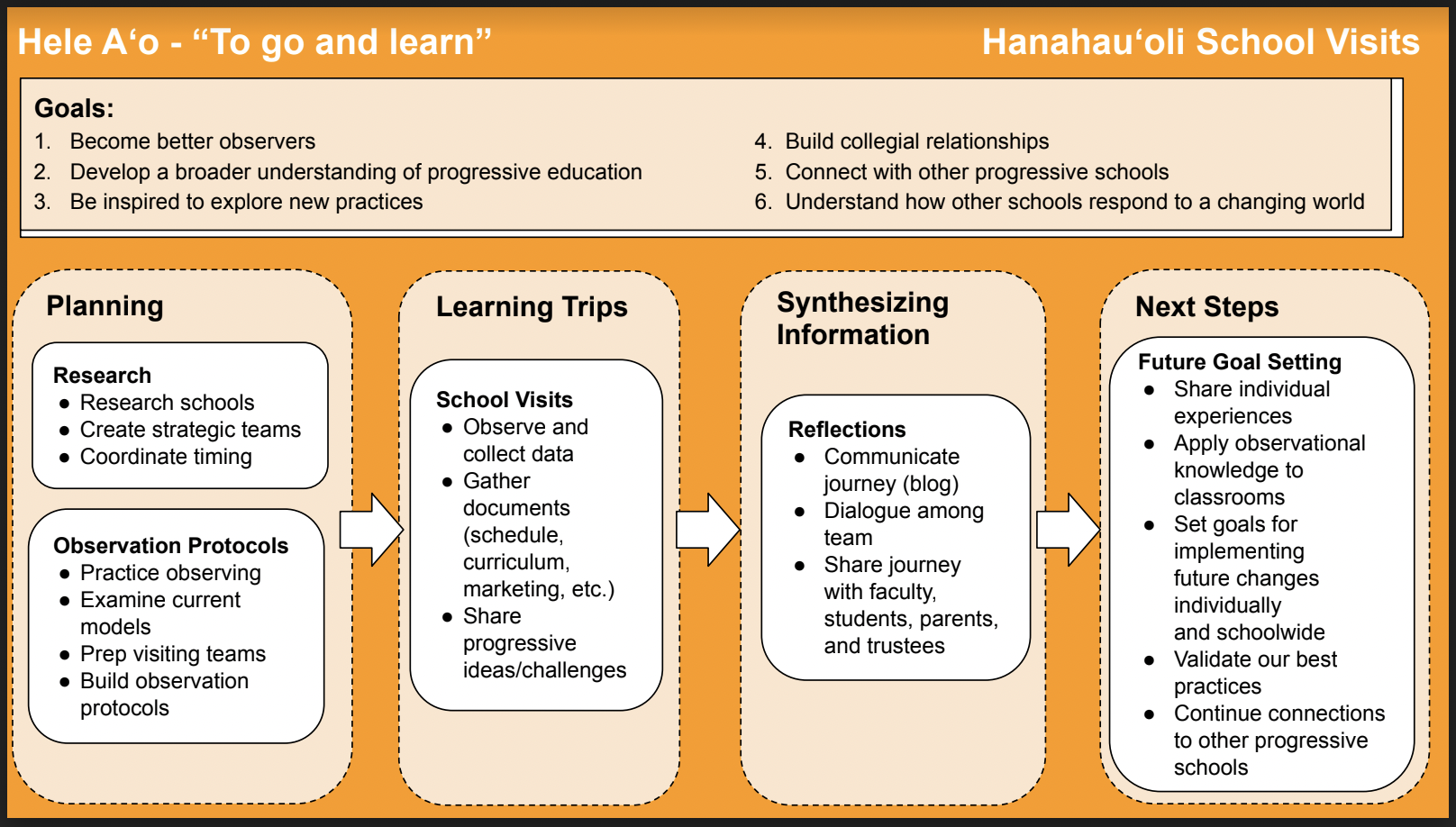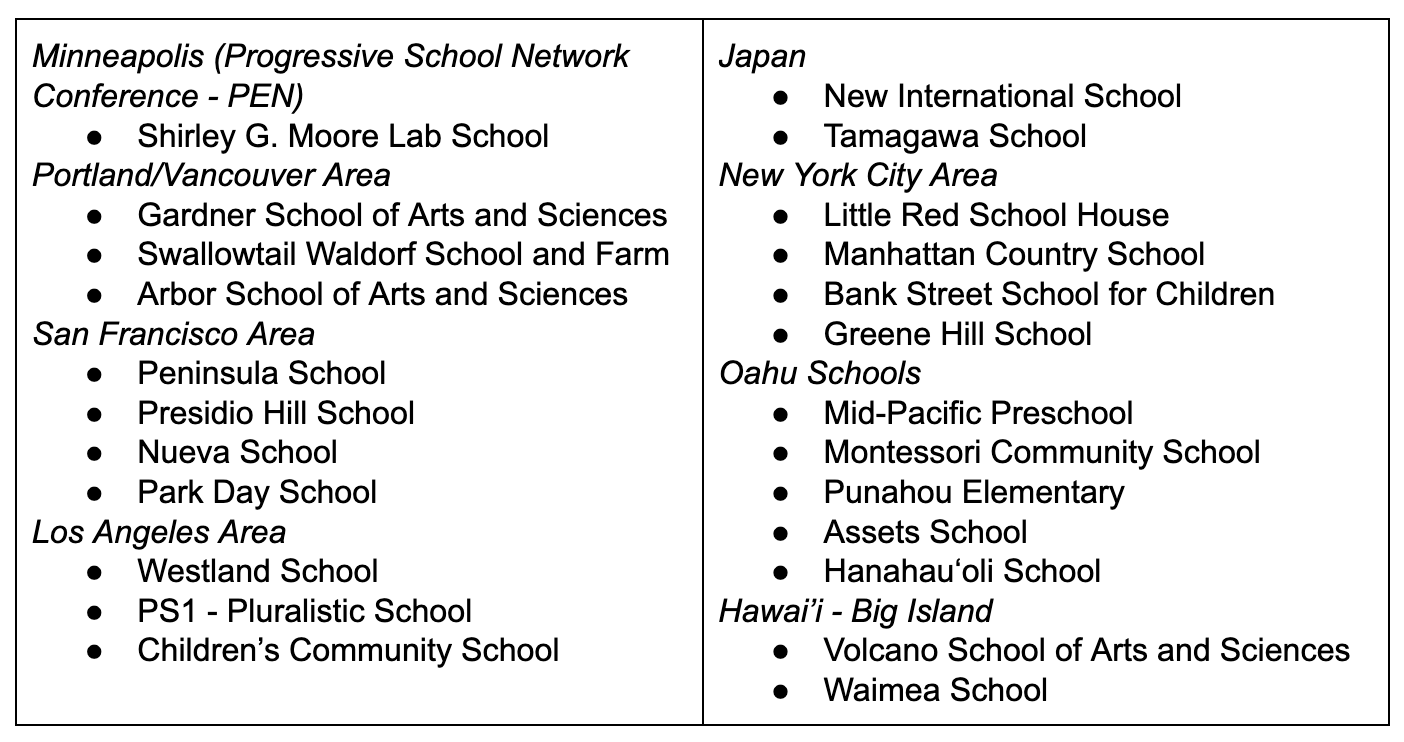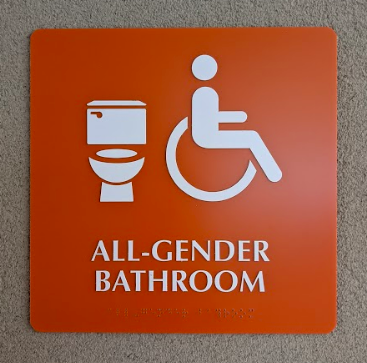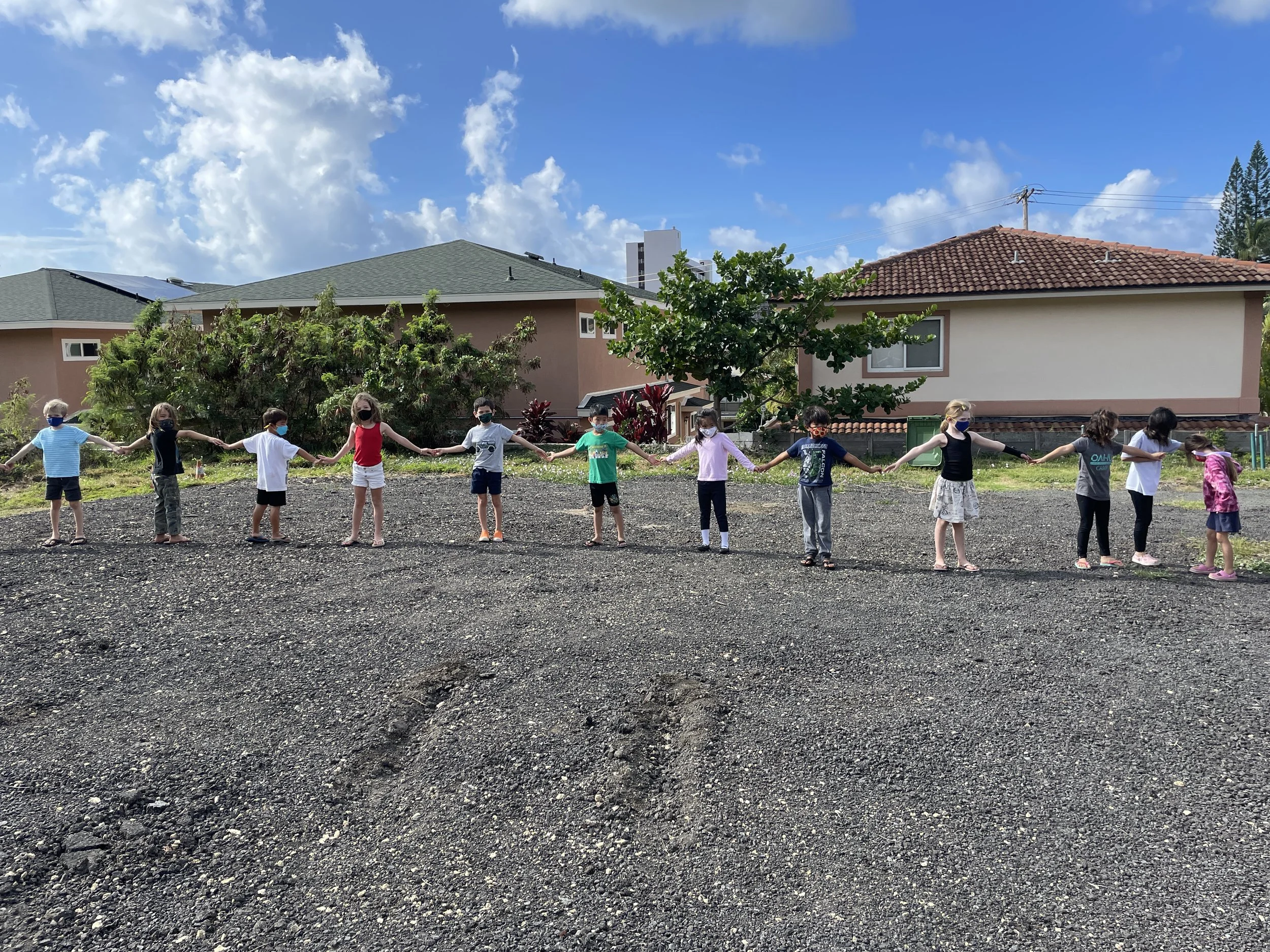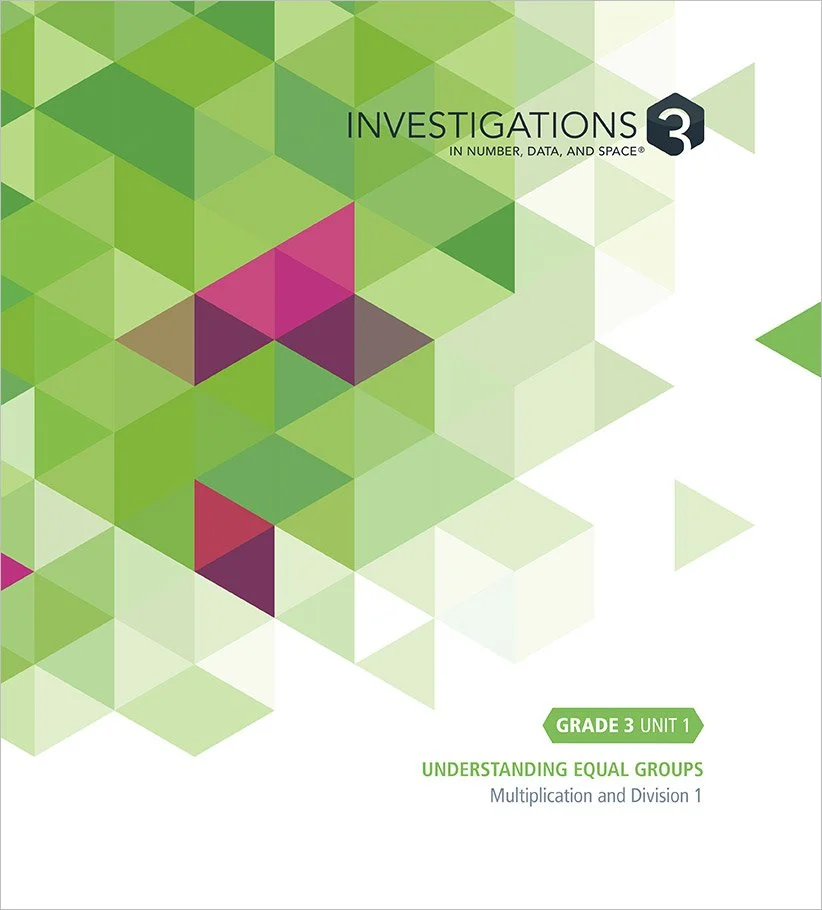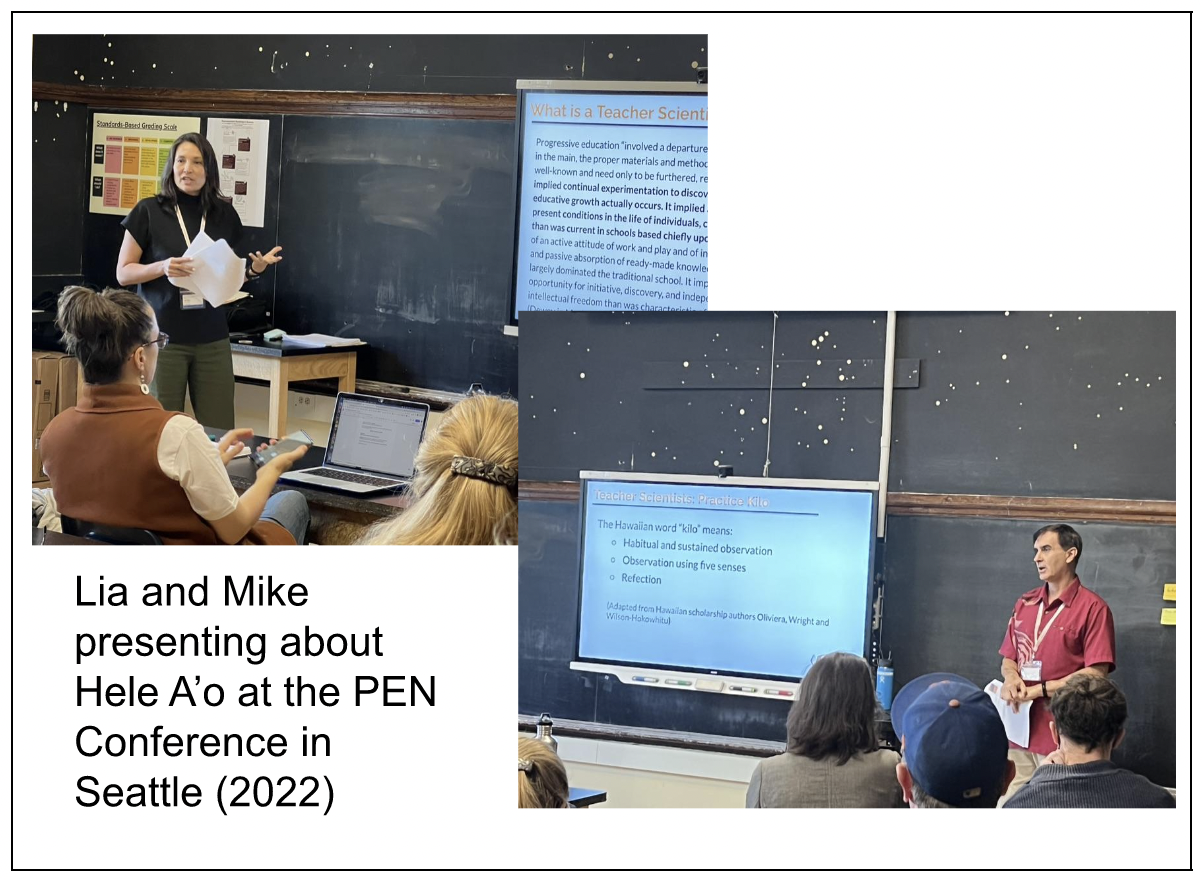By Mike Travis
Traveling more than 150,000 miles and visiting more than 20 different progressive schools, the faculty and staff at Hanahauʻoli used the 2019-2020 school year to bring back new ideas. Inspired by the school’s 100th year anniversary in 2018, Lia Woo (‘88), the new Head of School, was hoping the visits would inspire change and growth for the future. “After studying our school’s history, mission and beliefs, I wanted the faculty to look outward and learn from other progressive schools. By engaging in collaborative, experiential learning, faculty not only practiced their teacher-researcher skills but also helped inform future strategic priorities.”
The initiative was named Hele A‘o, which means “to go and learn” in Hawaiian. The goals of the program were to:
Become better observers
Develop a broader understanding of progressive education
Be inspired to explore new practices
Build collegial relationships
Connect with other progressive schools
Understand how other schools respond to a changing world
As the new Director of Curriculum and Innovative Technology, I was tasked with planning and organizing the trips. Working together with Lia, we researched the best schools to visit, taking advice from board members and others on schools to see. Some trips were close, for example, going down the road to Montessori Community School, but other trips took the educators as far as New York City to visit the well-known Bank Street School for Children.
The Hele A‘o initiative was more than just sending teachers to visit the schools, it was about growing the skills of the teachers to become better scientific observers. The professional development around this idea started even before the 2019-2020 school year during Hanahau‘oli’s before-school teacher professional development days. The teachers explored different activities to practice objective observations and looking for important details at the moment. It was about digging deeper into how a classroom might be run and the different ways to approach learning and teaching. As part of this work with teachers, a master list of questions was created that could be utilized on the trips to maximize the benefits and bring innovative ideas back.
Following is a list of the schools that generously hosted our visits throughout the Hele A‘o journey.
In February 2020, the final group of teachers returned from New York City, just a month before COVID-19 restrictions dramatically changed the world. During a professional development day in late February, faculty and staff came together to reflect on their travel experiences and share key takeaways from every school visited. We all shared insights, listened to others, identified themes, and voted on key priorities to pursue.
Rising to the top of our discussions were the following ideas:
Examining how to organize students into smaller class sizes
Analyzing ways to approach the school schedule/pace from a student-centered perspective
Brainstorming more ways to give teachers time to collaborate across grade levels and with specialists
Finding more time for students to explore their individual passions through electives, enrichment, or open studio time
Incorporating more diversity, equity, and inclusion initiatives throughout the school
Continuing growth in publishing and research, extending our progressive education leadership
Collaborating with other progressive schools on the nature of assessment and how we look at student growth and learning
Seeking more intentional use of outdoor space and nature
In March 2020, faculty engaged in continued dialogue and thinking around these initiatives, working to create proposals to be shared with the Board of Trustees. Coincidentally, the pandemic forced us to speed up our progress on several of these initiatives and further helped to determine priorities. The faculty and staff decided to focus their efforts on:
Refining the remote learning program for the 2020-2021 school year
Pivoting the Professional Development Center programming to a distance learning model, which in beautiful ways strengthened the school’s connection with many of the Hele Aʻo partners
Engaging in professional development on diversity, equity, and inclusion
Planning for school-wide elective time for students in the fall and spring
Examining the different ways in which Hele Aʻo schools assess learning
Finding more intentional use of outdoor space as we physically distanced cohorts during the pandemic, allowing us to create innovative solutions for the future
Hele Aʻo provided opportunities to meet other educators and to see and experience progressive education from other school perspectives. Some schools were young, others were just as old as Hanahauʻoli, but every school visit helped faculty and staff grow as teacher learners and develop the scientific habits of explorers, practicing careful observation, intellectual curiosity, reflection, and ideation. As John Dewey and other early progressive educators’ ideas continue to inspire and frame our thinking about teaching and learning, the Hele A‘o initiative moved the Hanahau‘oli learning community into a new century and helped teachers imagine the novel ways progressive educators can respond to our changing world.
Looking Back on Hele A‘o (Three Years Later)
Now, three years later, the school is reaping the benefits of this shared faculty experience. Hele A‘o did exactly what we hoped by infusing the school with new ideas. Looking back, here are some examples of changes at the school.
DEI - The work on Diversity, Equity, and Inclusion led to the creation of the Social Justice Committee. This group helped bring more education to teachers about equity and social justice, and new books and teaching practices into the classrooms. We have reconfigured our restrooms to be all gender and we are in the final stages of a new Social Justice Statement for our website that is grounded in our place in Makiki. In the future, we are looking at our misssion/vision statements through a social justice lens to see if changes need to occur there as well.
Elective/Enrichment Time - We have piloted different elective opportunities for students, including creating open studio time for students in our Physical World Lab (shop) and an Enrichment Week that occurred this year for all students. The hope is to continue the enrichment idea every year!
Use of Outdoor Space - The use of outdoor space was at the forefront of planning throughout the pandemic. The school leveraged outdoor spaces in new and different ways, which expanded perspective.
Assessment/Curriculum - Learning about the Math Investigations 3 curriculum from numerous progressive schools led us to pilot the math curriculum across multiple class levels (K-5th grade).
Publishing/Outreach - With the need for remote learning, the Professional Development Center (PDC) created new courses to help schools collaborate on ideas for remote learning. One of many exciting outcomes of this was the creation of the Progressive Philosophy & Pedagogy blog, which connects educators globally! We are also in the initial stages of creating a publication about our social studies/science curriculum across all classes.
Sharing and Connecting
With the return of the biennial Progressive Education Network (PEN) Conference, Hanahauʻoli School was able to meet and connect with many Hele A‘o Schools. Lia and I presented, “Hele A‘o: A Progressive Journey Around the World” to a packed room in Seattle. We started out by asking the group, “What is the most pressing question your school is wrestling with right now?” and “If you visited another progressive school, what would you want to learn about?” Then, we shared about our Hele A‘o trips and the key takeaways. We discussed the logistics and the challenges faced. We definitely could see some participants thinking about pursuing their own journey as well. We talked about our journey from the perspective of the conference themes: Disruption (Hele A‘o to challenge our thinking), Innovation (to bring back new ideas), and Regeneration (finding joy together in our practice of being teacher scientists). Based on participants’ answers to the initial questions, we broke them into small groups around related themes which included but were not limited to Play, Lack of Staffing/Space, Integrated Curriculum, Progressive Education & Maintaining Roots, Curriculum Mapping, Learning Loss, Onboarding New Teachers, and Enrollment. We gave each participant a copy of all our key takeaways from the Hele A‘o trips as a starting point for ideas related to the group themes. Then, we just let them share with each other. Our breakout session ended by having each group share their main topic, key takeaways from the discussion, and wonderings now. The discussions were so rich that many of the participants didn’t want to leave! This was my first PEN experience, and it made me realize how powerful conferences like this are, where educators with the same beliefs can get together, learn, and grow together.
What’s Next?
The work on change and growth is far from over at Hanahauʻoli School. The Hele A‘o trips were worth the investment in faculty and staff as a catalyst for new ideas and initiatives. Our school is moving into our 105th year of joyous work and we are emboldened to continue to grow and improve throughout the next century.
I close with an invitation to schools interested in creating their own Hele A‘o experiences to reach out to me at mtravis@hanahauoli.org in hopes our experience can support your own continued learning and growth.
ABOUT THE AUTHOR:
Dr. Mike Travis is the Director of Curriculum and Innovative Technology at Hanahauʻoli School, where he has supported teachers since 2019. A passionate, lifelong learner, Mike has been an educator for more than 20 years, working with students from elementary to graduate levels. Mike shares, "educators truly can make a difference in the lives of their students, so I always serve with a strong sense of responsibility for their success and an inner energy and enthusiasm that are contagious to all around me." Mike loves long distance running, spending time with family, and writing books.

